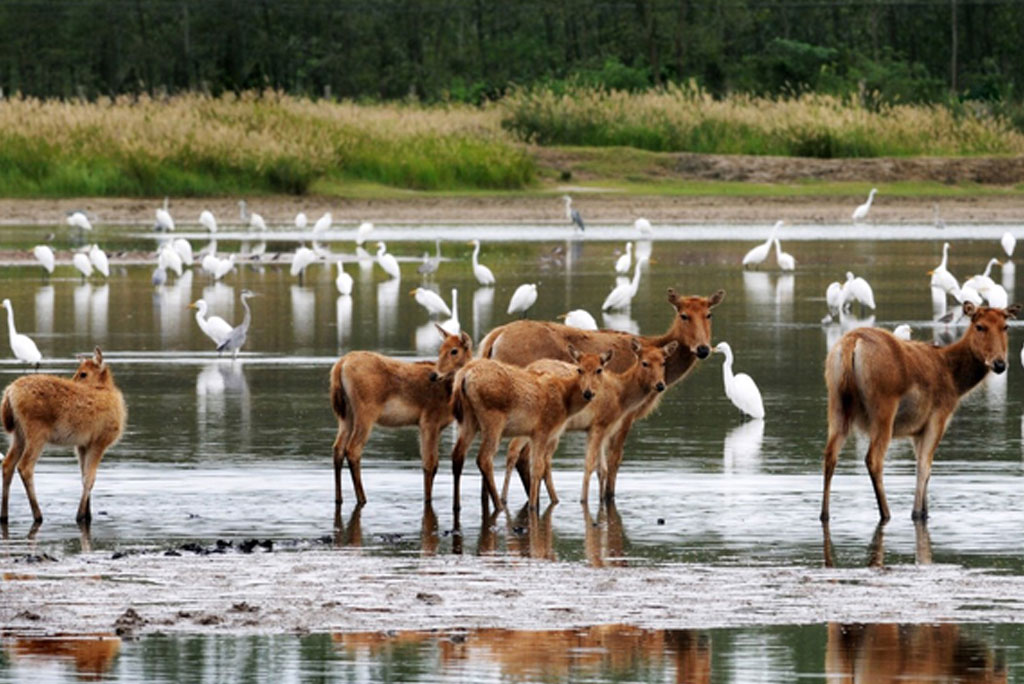East Asia Blog Series
An Integrated Approach to Preserving the Wetlands of the PRC
Zhiming Niu 12 Aug 2020
Restoring the globally important Yancheng wetlands required engineering interventions, forest rehabilitation, and capacity building.
Overview
One of Asia’s largest coastal wetlands is found in Jiangsu Province in the People’s Republic of China (PRC). Home to many migratory birds and animals, almost 300,000 hectares of these wetlands are in Yancheng municipality.
Yet, the Yancheng coastal wetlands suffered from rapid degradation. More than half of the wetlands had vanished because of reclamation for agriculture or industry, urban expansion, pollution, and poaching.
A project co-financed by the Asian Development Bank (ADB) and the Global Environment Facility (GEF) utilized an integrated ecosystem management approach to promote biodiversity conservation, sustainable forest management, and wetland-friendly farming and fishing practices in Yangcheng.
Project information
40685-013: People’s Republic of China – Jiangsu Yancheng Wetlands Protection Project
Project snapshot
-
-
- Approval date: 16 December 2011
- Closing date: 31 January 2019
- Total project cost: $28.68 million
- Executing agency: Jiangsu Provincial Government
- Financing: Asian Development Bank and Global Environment Facility
-
Context
The coastal wetlands of Yancheng span 291,300 hectares and include two national nature reserves, the Yancheng Rare Birds and the Dafeng Milu. These wetlands are home to the globally endangered red-crowned crane and about 70% of the world’s population of milu deer, also known as Pere David’s deer, which was once close to extinction.
The Yancheng wetlands also provide important ecosystem services to local communities. Marine and plant species protect against coastal erosion, tsunamis, and storm surges. They help improve water quality by filtering household and industrial pollution. The two surrounding forest farms provide additional ecological protection for the two nature reserves and are part of the national coastal ecological protection forest network. The nature reserves and forest farms attract thousands of eco-tourists each year from around the world, generating employment and income for local communities.
Development Challenge
There are three reasons for the rapid degradation, wildlife habitat loss and fragmentation, and loss of biodiversity of the Yancheng coastal wetlands:
- land-use changes from reclamation for agriculture, aquaculture, industry, and expansion of urban areas;
- habitat degradation, caused by excessive dehydration and rapid spread of invasive species, particularly Spartina alterniflora; and
- pollution from terrestrial sources.
Although nature reserves were established in the Yancheng wetlands since 1990, inadequate financing resources, limited management facilities and infrastructures, and weak institutional capacity restricted what the authorities can do.
From the 1980s to 2010, over half of the wildlife habitat vanished while the area of fishponds expanded eight times.
Solution
The Jiangsu Yancheng Wetlands Protection Project was designed to help the PRC improve the management of the coastal wetlands and preserve their valuable ecosystem functions. The project addressed constraints in protecting the wetland ecosystem by adopting an integrated approach. This includes the protection of the two nature reserves, the management of two forest farms, and capacity building to improve ecosystem management.
Various engineering interventions were used to protect the 3,812 hectares (ha) of wetlands at the Rare Birds Nature Reserve. Landscape regulation, habitats creation, and revegetation restored 540 ha of degraded wetlands. Water was pumped to 1,630 ha in the core zone, while 1,435 ha of fishponds were reconverted to wetlands. Pilots of invasive species control, particularly for the rapid spread of Spartina alterniflora, were also implemented for 207 ha.
The project also helped improve the environment of the milu deer by:
- Improving a total area of 742 ha of grazing habitat;
- Providing 25 ha of drinking water ponds;
- Creating 45 ha of grazing and resting ground; and
- Providing 242 ha fodder ground (119.5 ha for rotational closure and grazing).
Management facilities and structures were also improved in the two nature reserves through closure fencing, patrol roads and stations, waste management facilities, animal surveillance system, and public education centers.
Two forest farms covering 1,055 ha were improved and rehabilitated to provide habitats for birds and serve as shelter and protection. At the Yancheng forest farm, 185 ha were rehabilitated for birds; 302 ha of seedling nurseries were established; and 300 ha of agroforestry were developed.
At the Dafeng forest farm, 870 ha of wetland protective forests were improved. Systems and facilities for fire early warning and response, integrated pest management, and drainage works were installed.
The project developed operational management plans, conducted extensive training, and introduced a comprehensive ecological monitoring system to strengthen the institutional capacity of the authorities handling the two nature reserves.
Similarly, the management capacity of the two forest farms was largely improved through forestry management plans and staff training. They were linked to the two nature reserves to undertake bird monitoring, which was absent before the project.
Capacity development was extended to provincial institutions; international best practices from developed countries were discussed. Improving women’s capacity to perform various roles was also given attention.
Moreover, the project provided policy recommendations for developing an eco-compensation framework or an incentive system that provides stable financing for managing the protected areas. A provincial law, which took effect on 1 January 2017, set up the guidelines on eco-compensation for wetlands in the province. The provincial government is formulating the detailed rules.
Results
Enhanced protection of the wetland ecosystems
The project contributed to the successful listing of the Yancheng wetlands as a UNESCO World Heritage natural site in July 2019.
A total of 4,554 ha of wetlands were restored and rehabilitated, providing healthy and critical habitats for wildlife. This has enhanced biodiversity richness in the nature reserves.
- The number of bird species in the wetlands increased by 52%—from 25 types in 2016 to 38 types in 2018.
- The population of bird species increased by 24%—from 33,316 to 41,163.
- The population of birds at the core zone of the Rare Birds Nature Reserve grew by 365%—from 3,173 birds in 2016 to 14,747 birds in 2018.
- The population of milu deer has reached 5,016 heads (1,350 in the wild) by 2019, accounting for over 70% of the world population and increasing by 180% from 1,800 heads in 2012.
In terms of climate mitigation, the project increased carbon sinks in the wetlands and forest biomass as well as lessened air pollution.
Improved livelihood and participation of local communities
The project created employment opportunities for more than 2,900 people in the area, nearly half are women, through improved ecological farming and fishing practices as well as ecotourism and forest-based small businesses. Around 40 hotels and restaurants have opened in the project area since 2017, providing jobs and additional revenues.
Both nature reserves have become popular tourist destinations, attracting more than 1 million visitors annually. The Dafeng Milu Nature Reserve has been upgraded to a 5-star tourism site, the highest level in the country in 2015, and is expecting more visitors in the future. The public education facilities that were established in the nature reserves have catered to 30,000 students annually as centers for learning in the environment and biodiversity.
The project also promoted the effective participation of local communities. Project beneficiaries were trained in eco-farming, fishing, and off-farm skills; 60% of beneficiaries are women. The training activities strengthened community awareness and skills for wetland-friendly farming and fishing practices. It also improved the capacity of local government authorities to manage the coastal wetlands and to meet international standards to keep Yancheng’s world nature heritage status.
Lessons
Enhanced institutional capacity and monitoring systems are key to improving the condition of the wetlands and sustaining ecosystem services and functions.
The project demonstrated the following promising measures in the management and protection of coastal wetlands:
- invasive species control;
- conversion of fishponds into wetlands; and
- revegetation of forest habitats.
Such interventions need to be continuously reviewed to assess their long-term effectiveness. Restoration works need to take natural processes into account, particularly in formulating ideal habitats for migratory waterbirds and maintenance of restored wetlands.
Continuous international collaboration in managing heritage sites is important to share and build on existing knowledge. Partners include the Convention on Biological Diversity and Ramsar Convention on Wetlands, International Union for Conservation of Nature, and World Wildlife Fund.
References
ADB. 2020. Completion Report: Jiangsu Yancheng Wetlands Protection Project in the People’s Republic of China. Manila. Unpublished.
ADB. 2018. Preserving the Wetlands of the People’s Republic of China.
ADB. 2008. Report and Recommendation of the President to the Board of Directors: Proposed Loan to the People’s Republic of China for the Jiangsu Yancheng Wetlands Protection Project. Manila.
Author

Zhiming Niu
Senior Project Officer (Environment), East Asia Department, Asian Development Bank
This blog is reproduced from Development Asia.


